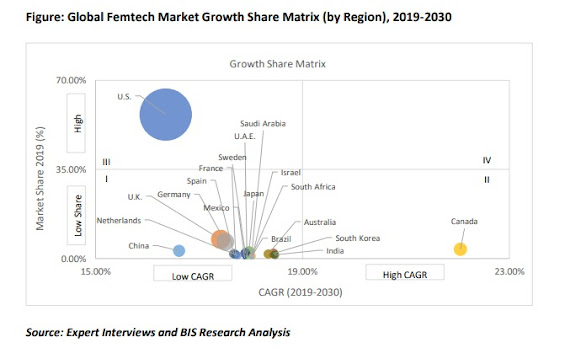The growth of the Female Technology (femtech) market indicates that the industry is on its way to breaking some of the existing barriers. The increasing interest in femtech has kickstarted a start-up ecosystem focused on women’s health.
In an optimistic growth scenario, most of the countries are likely to be in the second quadrant, with CAGRs higher than 19%. Some of the countries with the fastest-growing femtech market are Canada, India, South Korea, Australia, and Israel. Most of the countries lie in the first quadrant, i.e., low market share and low CAGR. The U.S. is likely to remain the leading market for femtech in 2030.
Grt Free Sample Report - https://bisresearch.com/requestsample?id=1002&type=download
Key USPs of the Report
Following are some of the key contents of the report:
• Funding Analysis
This chapter encompasses a description of the current funding landscape in the global femtech space, along with an assessment of the deal count of venture capital firms during the period 2018-2018. The chapter also assesses the state of private funding in the femtech market.
This chapter will enable the readers to obtain a better understanding of the way in which the funding scenario has evolved in the past few years and identify some of the key investors in the femtech market.
• Business Model Analysis
This chapter comprises information on the key business models deployed in the market by leading players
In addition, the report provides:
• A detailed analysis and growth forecast (2019-2030) for different market segments
• Recent developments and trends in the global market landscape
• Factors promoting and inhibiting the market growth
• Assessment of the funding scenario
• Market trend assessment for pregnancy postpartum offerings
Key Questions Answered in this Report:
• How has the femtech market landscape evolved in the past decade?
• What is the present status of femtech adoption globally?
• Which are some of the leading players in the femtech market?
• What are the different business models in the global femtech market?
• What are some of the untapped opportunities for the femtech market?
• How are the companies operating in the market generating revenue?
• What are leading technologies which will witness increased adoption along with femtech?
• What is the funding scenario of the global femtech market?
• What is the state of femtech adoption in the Middle East and Latin America?
• What are the existing barriers to technology adoption in different regions?
• What are the influential trends in the fertility services market in femtech?
• What are the regulatory guidelines concerning femtech apps and software in key regions?
• What are some of the key features of apps available in the market?
For more information on this report visit - https://bisresearch.com/industry-report/female-technology-market.html









